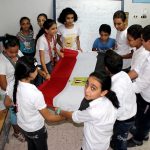By Mariam Ibrahim – Mada Masr –
Is a religious narrative that frames the killing of Copts as God’s will at odds with mounting resistance to sectarian attacks?
“We never dreamed our brother Mina would be a martyr. He’s a hero, a saint just like Mar Girgis, and Mar Mina,” declares Mina’s sister, Dimyana Fouad, in the wake of his death in the Palm Sunday bombings in Alexandria earlier this year. Huddled in one of their home’s two rooms, the family passed a blood-soaked shirt around.
The blood is the son’s, the shirt the father’s. “I held him in my arms,” his father says, choking up.
Mina’s wife, daughter, parents, and brother — who was also wounded in the bombing — along with members of the extended family, speak about the incident, taking turns to wrap the shirt around their bodies.
“He healed my knees,” says Yoliana, another one of his sisters. “I’ve had bad knees for a long time, and I would often complain to him about it. Last night, he appeared to me in a dream, and when I woke up the pain was gone, all gone.”
Martyrdom and the Coptic Church
Apparitions and accounts of miraculous healing, like that of Yoliana, are very much part of folk Coptic culture and are usually associated with canonized saints and martyrs. Relics of martyr saints occupy the entrances of Coptic Orthodox churches, where they are displayed behind glass counters in wooden boxes wrapped in crimson cloth.
Commemoration ceremonies for martyr saints borrow from the burial rites of Jesus described in New Testament accounts. Churches housing relics of martyr saints often become sites of pilgrimage, and believers frequently pray to them for intercession in their troubles, sharing among themselves the miracles performed by saints and martyrs in their daily lives.
Evelyn Said, 53, whose brother-in-law was killed in the Palm Sunday bombings in Tanta this year, believes that “martyrdom is an integral part of our faith.” She describes growing up in a small town between church and family. The body of Martyr Saint Sedhom Bishay was on display in her church. He is the martyr she most relates to — “I consider myself his daughter.”
“The martyrs in Tanta will have a church named after them, and their stories will be published. They will enter the Synaxarium!” she exclaims.
During Church services, as part of the liturgical mass, there is a reading from the Synaxarium, a calendar-style volume of books made up of hagiographies of martyr saints arranged by the date of their death. The date of a martyr’s death is considered to be the date of their heavenly birth into eternal life.
Priest Yacoub, who serves in the Deir al-Garnous parish — which recently lost seven men in the mass shooting in Minya on May 26 this year — relates the story of one of the Synaxarium’s first authors. Himself a Christian, he would follow other Christians on their way to bear witness to their belief in Christ in the Roman courts. They would be sentenced to death, and he would take their bodies back to their hometowns and document their stories.
Priest Yacoub defines martyrdom in the Coptic Christian faith as, “bearing witness to Christ through holding onto the Christian faith in all circumstances, including persecution and discrimination.”
According to early Christian teachings, to present martyrs to Christ is a source of pride for any church, as death and martyrdom for one’s faith is considered the highest form of communion with Christ. This can be seen in the common naming of churches after canonized saints, and recent moves to rename churches that have suffered sectarian deaths in their own congregations.
When a Copt dies, it is common for the immediate family to get a photograph of their loved one photoshopped onto a heavenly background along with images of Jesus and other canonized saints and martyrs. This is later printed for use, particularly in religious ceremonies commemorating the death, including prayers that take place three days and 40 days after the death.
In the event of sectarian killings, these posters take on special significance, and are circulated both online and in print. Extended members of the community often create these posters as a form of tribute to the dead, and to emphasize their martyrdom status.
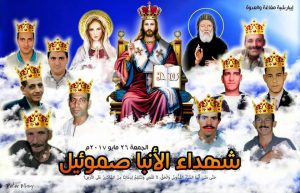
Poster commemorating victims of the attack in Minya. (Courtesy: 3adma Zar2a Facebook page)
By the time of the third-day prayers in Deir al-Garnous village in Minya, one such poster was hung over the main entrance door of the church. Photographs and names of each individual from the village killed in the incident are at the bottom. An image of Jesus dressed in white with outstretched arms takes up the top center, while the Virgin Mary is on his right, and Father Samuel the Confessor and his monastery building (to which they were headed) is on his left, each surrounded by a halo of white light. The backdrop is blue, and flanking the scene are angels in prayer.
Imagery of martyr saints decorate churches, homes and bodies of the faithful. The Coptic revivalism movement, led by both laypeople and clergy, bloomed in the early 20th century, coinciding with the rise of Egyptian nationalism, and made use of the advent of modern modes of reproduction to proliferate religious imagery of martyrs. Stories of martyr saints are presented in the form of songs called glorifications, and printed on the back of postcard-size pictures of the corresponding martyr saint. Some stories are collected and printed in anthologies, and some have been made into films produced by the church and affiliated producers in the late 1970s.
Writing about church-produced cinema in her article, “Sacred Women in The Coptic Cinema, Between Faith and Resistance,” anthropologist Lise Paulsen Galal asserts that these saint narratives, because of their “sensuous and magical” aspect, are stories about the active Copt, rather than the passive one. “By presenting transgressive identities, the mediated stories offer the Coptic audience a position as subjects with agency instead of a position as submissive objects of the majority’s oppression,” she explains.
Ishaq Ibrahim, a researcher on religious freedoms at the Egyptian Initiative for Personal Rights (EIPR), says that the emphasis on martyrdom and perseverance through the ages has helped the Christian faith survive in Egypt, despite centuries of persecution.
The martyrs emphasized in church narrative are from the Roman period, while deaths from some of the longest lasting Coptic revolts are almost entirely absent. Ibrahim says that this erasure reflects the tendency of history to present the perspective of the oppressor and not the oppressed, and that the church has often sided with the ruling classes and structures.
Martyrs for the state or God?
During the funeral of the victims of the Minya shooting incident, in which 29 people were killed by gunmen, Bishop Agathon of the Maghagha and Adwa Diocese opened his sermon by declaring, “Our children are martyrs of the homeland before being martyrs of Christianity.” He went on to say, “All those who had a role in protecting Egypt’s national identity through participating in June 30 are being punished [by the attackers]; the military, the police, the judiciary, Public Prosecution and Copts are all paying the price.”
This was met with some boos from the crowd, along with chants of “With our blood, with our souls, we sacrifice for you, O cross” and lamentation from mourners, which the bishop repeatedly tried to silence with proclamations of joy at the church having gained martyrs in heaven.
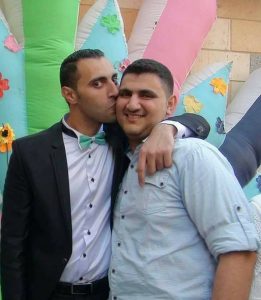
Image of Kirollos and Gerges Mahrous, two brothers who were killed in the Minya shooting. (Courtesy: Martyrs of the Monastery of St.Samuel 26 May 2017 Facebook page)
By placing these deaths within the framework of the war on terror launched by President Abdel Fattah al-Sisi’s government following the ousting of the Muslim Brotherhood in the events of June 30, 2013, Ibrahim argues that church officials, in their role as spokespeople for the community, enable the authorities to get away with their failure to mitigate violence against Copts.
“Attacks against Copts cannot be equated with attacks against police and the army,” he asserts. “There is a difference between targeting representatives of the state, such as the police or the military, and identity-based killings. The targeting of Copts for participating in June 30 and subsequent events, through attacking churches and Coptic civilians, is a form of collective punishment for exercising their political rights as citizens.”
The notion that Christians killed in recent attacks are martyrs to Egypt in the war against terrorism comes not just from the church, but from the state and supportive media.
Video footage of Nessim Fahim, who was killed in Alexandria in the Palm Sunday bombings, in which he is seen directing a man, presumed to be the bomber, to the metal detector minutes before the explosion, went viral and was broadcast on several mainstream media outlets. His wife and two sons appeared on host Amr Adib’s television program, during which Adib emphasized that Fahim had saved the entire alley, not just the church, feeding into the narrative that Copts are martyrs to the nation and the war on terror.
Addressing the country on the day of the Palm Sunday bombings in a press conference in which he announced a three-month state of emergency, Sisi declared, “All of this is for Egypt, for Egypt’s future. We know this is a big sacrifice, but we are ready to make this sacrifice.” In a subsequent speech on the day of the May shootings in Minya, Sisi began his speech by offering his condolences “to all the Egyptian people, and to all Egyptians on occasion of the martyrs that fell from the people of Egypt who are Egypt’s children.” He went on to say that “the goal of committing these acts is to bring down the Egyptian state.”
Anger with church and state authorities
Family members of Reyad Wahib, killed in the Minya shooting, agree with the bishop who led the funeral service that Copts are being targeted for supporting Sisi. While they see that this is “the price we have to pay for fighting terrorism,” they are also angry.
“I’m not sad that my husband is a martyr. But I’m angry at what they did to him,” says Wahib’s widow. The family expresses grief and anger, not just at the brutality of the deaths, but at the ineptitude of the authorities in their response to the shooting, as well as the erasure of their everyday suffering as Christians living in Egypt.
“Church officials are busy exchanging pleasantries with government officials, while we, the people, are crushed in the middle. There are no human rights in this country,” Wahib’s brother-in-law says. “What has the state done for us? They are quick to seize land in Fayoum from laborers, but when it comes to catching and punishing murderers, they do nothing.”
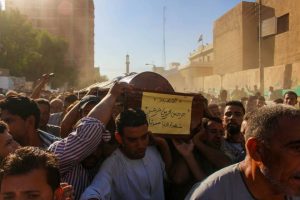
Funeral of Gerges and Kirollos Mahrous (shown in previous photo), who were killed in Minya – Courtesy: Mo’men Samir
Hanna Ayad, a driver from one of the neighboring villages, describes how dozens of Copts demonstrated in front of the bishop’s headquarters in Maghagha, as well as the general hospital and the police station, and blocked train tracks with their bodies. They were protesting the killings, but also what they saw as nonchalance displayed by the security forces and health workers in the governorate. Ayad recounts that the truck carrying the bodies of the dead was subjected to sectarian slurs of “infidels” and “we hope they kill you all,” from some passersbys. They were able to catch one of them, but “then he was rescued by the police, who took him into custody to get him away from us, and then they released him without pressing any charges.”
Protests by relatives of those killed also took place after the bombing at the Abbasseya Cathedral in December 2016, when protesters objected to their exclusion from the official military funeral at which state figures were present.
The end of times or the height of sectarianism
Ibrahim says that the church’s emphasis on martyrdom does not harness this anger. While he sees that the centrality of martyrdom to Coptic practice and faith has helped it survive, he is critical of church rhetoric that promotes an excessive valorization of suffering and martyrdom.
He argues that it is dangerous because it can promote disengagement with civic life as the afterlife is presumed to be more important than the present life. “There are several ways to bear witness to God that do not necessarily entail death and suffering. This is not to belittle people who, in the face of death, choose to die rather than denounce their faith.”
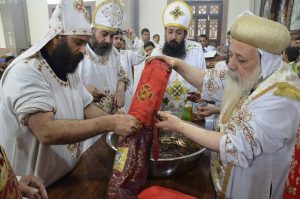
Priests preparing relics Saint Martyr Armanios (Courtesy: Facebook page of the Coptic Orthodox Diocese of Mallawi in Minya) – Courtesy: Facebook page of the Coptic Orthodox Diocese of Mallawi in MInya
Priest Yacoub, however, does not believe that celebrating martyrs is an impediment to demanding citizenship rights for Christians. He quotes Bishop Rafael’s sermon during the funeral for the victims of the Palm Sunday bombings in Tanta on April 8, 2017, in which he says, “God put us on this earth to live. We hold onto our faith in all circumstances, but that does not mean that we commit suicide.” Yacoub goes on to say, “Christians are citizens of Egypt with rights and duties, and it is the role of the state to ensure that they are treated as equal citizens, and they serve in the military and police like their Muslim counterparts.”
But neither the church nor the state, Ibrahim believes, want a strong Coptic civilian movement that demands rights and representation for Copts in Egyptian civil life.
Civil demands are absent from the church’s discourse, he explains, which is more oriented toward preaching passivity and submissiveness in the face of sectarian violence as the Christian thing to do.
“But even when Saint Paul, one of Christianity’s first martyrs, was arrested by the Roman state, he demanded a fair trial on the basis of his Roman citizenship, and was adamant about his rights as a citizen of a country with certain laws and rights,” Ibrahim says. “He did not say for Christ, ‘I will do anything, so go ahead imprison me, torture me and kill me.’”
Said, whose brother-in-law was killed in the Palm Sunday bombing in Tanta, feels that is important for Copts not to be passive in the face of day-to-day sectarianism either. “I do not like submissiveness, our God is a mighty God,” she says as she relays an incident that happened to her son on the school bus. One of the children said to him, “You are unclean because you are Christian,” and shoved a cold drink down his back. She had her son point him out, and told him off.
It was important for her to stand up for her son’s rights. And he now stands up for himself. 20-year-old John describes how in 2011, after the bombing of Two Saints Church in Alexandria, a classmate came up to him and told him “I wish they had bombed you all.” John complained to the school principal, who took disciplinary measures against his classmate. “I felt glad that I spoke up, and that I was listened to. I knew it was the right thing to do.”
Said understands the Palm Sunday bombings as the sign of a new epoch of martyrdom, and the end of times, and thus, in a sense, inevitable. “One brother died, while his brother, who was next to him, survived — surely this is a fulfillment of what is said in the Book of Revelation,” she says. Her comments echo the remarks of Bishop Morqos, the bishop of Giza, who stated in his sermon on the third day of prayers in Deir al-Garnous in the wake of the Minya shooting, that the December Cathedral bombing and subsequent events mark a new epoch of martyrdom. “Our Church started with St Stephen (the first Christian martyr after Christ), and will continue to offer martyrs till the end of time. We thank God that he permitted this pain so that we too can prepare ourselves, for nobody knows when their time will come.”
These escalating attacks, Ibrahim says, are part of the ongoing violence against Copts, in the absence of any accountability for sectarianism and sectarian acts by state and non-state actors.
While Said expresses pride and joy in the measures the church has taken to commemorate those who died, including adding them to the Synaxarium, her son says, “We have the right to not rejoice about what happened.”
__________________
Photo credit: Palm plants stained with blood, after the Palm Sunday bombings in Alexandria – Courtesy: Sara Younes





